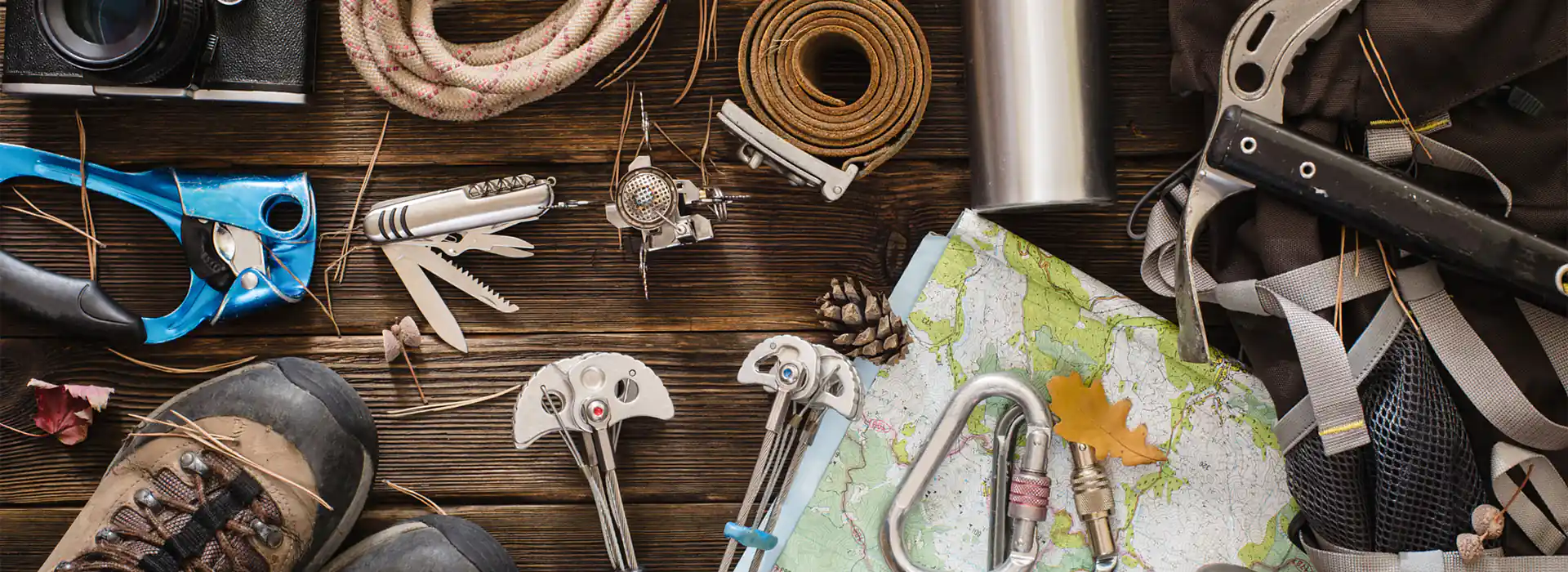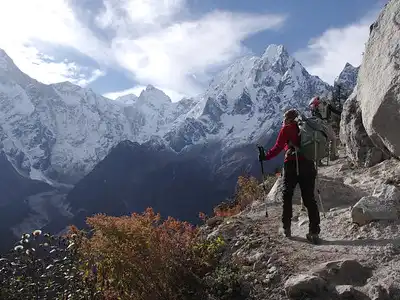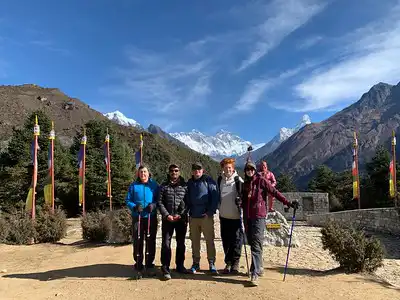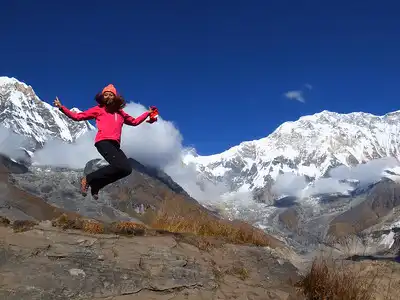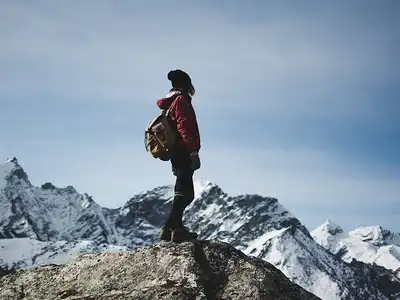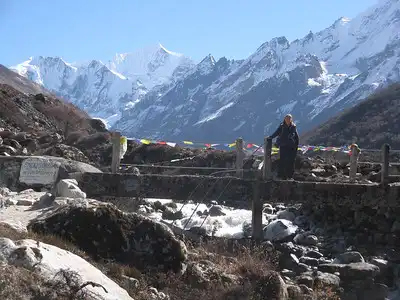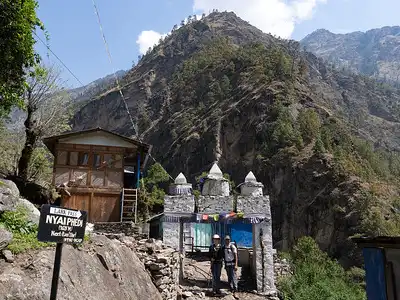Peak Climbing Equipment aids in keeping your stride fluid and keeps your body in proper alignment during the trek. Several peak-climbing equipment is highly crucial for consistent climbing.
Specific Peak climbing gear
- Climbing Ropes
- Carabiner
- Crampons
- Blocking Plates
- Ice Axe
- Trekking Poles
- Trekking Helmet
- Harness
- Ascenders
- Pulley Mechanism
- Nylon Connectors
- Avalanche Detector
- Velcro strap
Pieces of personal wear
Outer attire
- Water-resistant jacket
- Woolen T-shirt
- Thermal Trouser
- Mid-layer jacket
- Softshell pants
- Raincoat
- Windproof Hardshell jacket
- Breathable t-shirt
- Woolen Sweater
Inner Attire
- Light Undergarments
- Tank tops
- Complete sleeve woolen first layer
- Long Underwear
- Boxer
Head’s apparel and gears
- UV-protective goggles
- Woolen Scarf
- Woolen Caps
- Bandanna
- Hats
Attire for Hands
- Thermal Layer Gloves
- Fingerless gloves
- Liner Gloves
- Fabric/woolen Gloves
Footwear
- Liner Socks
- Cotton Socks
- Mountaineering Boots
- Long thread Boots
- Climbing Socks
- Synthetic Boots
Rucksacks
- Small Bags
- Hand Bags
- Duffle Bags of around 40 Liter
- Bag cover
- Waterproof 120 Liter Duffle Bag
- Padlocks
Accessories & Hygiene
- First Aid Kit
- Earplug
- Antibiotics
- Water Filter/ Water purification tablets
- Painkiller/ Anti-Cold Tablets
- Bottles
- Power Banks
- Spf Sunblock creams
- Nose guard
- Synthetic Towel
- Hand Sanitizer
- Tissue papers
- Digital Camera
- Matchbox
- Headlamp
- ATM/credit /debit card
- Reading books and cards
- Toothbrush
- Sleeping Bag
- GPS & Map
- Local Sim Card
- Mobile Phone
- Pocket Knife
- Mug/bowl/cup
Energy providing bites
- Chocolates
- Dry fruits
- Juice
- Energy Drink
- Milk products
Essential Documents
- Passport
- More than 6 Passport Size Photos
- Travel Insurance
- Proof of PCR test (not compulsory)
- Identification Card
- Travel details
Where can I buy Climbing Gear
Trekkers frequently stop through Kathmandu and Pokhara before beginning the arduous high-mountain trek in the northern region of Nepal. Kathmandu and Pokhara serve as significant tourism and visitor hub, and most trekkers begin their journey from either city. Similarly, you may purchase climbing equipment elsewhere, although you can buy all essential items in these two big Nepalese cities. Additionally, since you may bring your accessories, buying them is not necessary. However, because trekking gear is a crucial component of the trek, you must obtain it.
High-quality goods with worldwide and regional brands are available in each location. It would be best if you were cautious of the scam involving duplicate copies of the items. It is similar to most of these hiking supplies outlets in Kathmandu’s Thamel District and Pokhara’s Lakeside District. Also, a few stores in Thamel are selling high-quality Peak Climbing equipment. From sleeping bags to waterproof jackets and everything trekking necessities like ice axes and carabiners, you can get them at Thamel. Furthermore, other apparel stores sell hand accessories only in Thamel.
Additionally, Pokhara has a wide range of clothes retailers. Professional hiking boots, eyewear, thermal apparel, and headgear are available for peak climbing. Besides this, many stores in Durbarmarg sell the best gear for peak climbing. The climbing gear sold at these stores is of standard quality and well-crafted. Furthermore, you may acquire peak climbing equipment with Russian, American, and South Korean labels having the most acceptable evaluations concerning Nepal.
Peak-climbing equipment’s importance in Nepal
Nepal has numerous peaks, most of which are over 5000 meters high. These peaks extend from the west to the east of Nepal and have different degrees of severity. Thus, one needs to establish a routine of using peak climbing equipment to its maximum capabilities to climb high peaks. The significance of these peak-climbing tools will gradually become more apparent as you make your way closer to the peak and climb over 3000 meters in height. As a result, this equipment makes climbing more accessible and helps you during the expedition’s frustrating aspects.
In Nepal, one may climb more than 30 distinct peaks. Lobuche, Island Peak, Mera Peak, Chulu East, Chulu West, Yala Peak, Hiunchuli, Mardi Himal, and Pisang are the most famous peaks. These peaks span interstellar distances from the west to the east of Nepal. Furthermore, the consistent elevation of these peaks puts the climbers’ utmost climbing techniques to the test. As a result, you must concentrate on utilizing the peak-climbing equipment before climbing to use it without difficulty when you reach the summit. The climbing course will also be available, so you may learn how to utilize the equipment before climbing.
Moreover, if the temperature is below freezing and you are above 5000 meters, you may need equipment like an ice axe and pointed axes to smash through the icy conditions. Another difficulty is the variable weather in Nepal’s Himalayas. You may never know when you’ll encounter snow or torrential rains. You may get the best assistance from waterproof backpacks and jackets. Besides, you will enjoy the high camp and summit tenting when peak-climbing. A specific sleeping bag can help you with this so you may remain the night at a greater altitude and be comfortable.
The total cost of Peak climbing equipment
Here below are the price lists of crucial Peak Climbing Equipments
Climbing Ropes – USD 20
Carabiners – USD 15
Harness- USD 20 to 80
Helmet – USD 50 to 200
Gloves – USD 10 to 30
Ascenders – USD 50
Trekking Poles – USD 30
Trekking Boots – USD 200
Sleeping Bag – USD 150
Sunglasses – USD 10
Water Bottle – USD 5
Woolen Socks – USD 10
Backpack – USD 15
Duffle Bag – USD 8
You can purchase the essential peak climbing gear from USD 500 to 700. Depending on your brand, it can take less in various places. Similarly, certain stores may charge you more than usual, so you should study the equipment before buying it. Furthermore, some trekking footwear will be more expensive in Thamel and Durbarmarg. You can also acquire the correct pricing if you know the climbing equipment’s rates. Also, the cost of bags differs depending on where you buy them, so you should choose a store with the lowest prices.
Renting genuine types of equipment
Purchasing peak-climbing gear might not always work out because you won’t spend all your time in Nepal climbing every mountain. Similar to carrying the peak climbing gear, renting the gear is an option if you want to climb for a brief time and have the essential climbing ability. You may rent equipment from most places in Kathmandu’s Thamel region, which is the city’s commercial and artistic core. Since renting is far less expensive than purchasing, most trekkers rent their equipment before beginning their ascent of the peaks. These rental locations are all across Thamel, and you can also ask your tour guide for specifics on the Climbing equipment available.
A large portion of the cost of purchasing climbing gear may be minimized by renting it. Renting the equipment is, therefore, not anything you should think twice about. Because most warehouses will rent it at a meager price, this will be your most cost-effective option. Additionally, you frequently get the ideal climbing companion with this equipment. For instance, purchasing trekking poles would cost you close to $100 to $150, but renting them out would only cost you $5 or less a day, or about 1/3 the price. As a result, if you want to rent peak climbing equipment, you might immediately go to Thamel and obtain it. Additionally, renting most of the equipment from the Thamel costs approximately USD 1 to 5.
Purchasing Equipment from Independent Retailers
There will also be several local businesses in the Kathmandu Valley’s Thamel where you may buy the stuff, mainly clothes. These neighborhood shops frequently market their goods using sweeping machines and other equipment. These items are less expensive than similar ones from stores and other outdoor retailers. The customary Nepali trekking boots, poles, and even backpacks will be there, which you can get quickly. Before choosing to purchase from a local merchant, you should understand the pricing. Nevertheless, some merchants may offer you fantastic pricing, so you should check with them. Furthermore, most of the merchandise from these individual merchants is favored for peak climbing.
In such case, you may go to these shops if you want to go climbing for a few days and get the conventional equipment of your choice. However, imitation goods occasionally could not be beneficial—for example, they might come apart or break when you’re scaling a mountain. You may also ask the locals and tour guides to obtain information on smaller retailers. By supporting independent merchants, you help them expand their businesses and provide for your family. But the fact is that they must also provide high-quality trekking gear that helps climb. It will also be wise to get additional climbing gear from independent retailers to regulate your expenditures.
Peak climbing necessitates a higher level of equipment than trekking.
One of the most challenging aspects of mountaineering in Nepal is peak climbing. When ascending a peak, you must proceed to the summit while traversing several base camps. The trials will be entirely consistent, and occasionally there will be no trials; you have to locate the trial on your own. To use your climbing gear as efficiently as possible to reach the peak, you should follow in the footsteps of the guides left behind.
Climbing equipment is extensively functional during peak climbing. The typical height you will acquire during peak climbing will vary from 5000 and 6000 meters, which will be strenuous. In Nepal, trekking is also tricky; however, it is not as challenging as peak climbing. Nepali treks often follow a route that goes by most of the country’s settlements while providing breathtaking views of the Himalayas. Some trekking trails may be steep and challenging, with no equipment usage.
All you need are trekking poles to propel yourself upward during the trek. Furthermore, you’ll gain an average of 3000 to 4000 meters of height while trekking. The same is true of hiking, which is more straightforward in Nepal than trekking and peak climbing. However, unlike trekking and hiking, peak climbing necessitates the proper use of equipment as well as high-level climbing equipment.
As the climb progresses to the summit, where there will be a lot of snow and ice masses, you may occasionally need to use an ice axe. Furthermore, to get a hold of the snow, you must wear excellent trekking boots. Moreover, several more climbing equipment is essential for peak climbing that is used at every level once you pass the 4000m altitude mark.
Precautions to consider before utilizing Peak Climbing Equipment
In general, all you need is some basic understanding to operate climbing equipment. For ease of navigation, you must know how the climbing equipment functions. Additionally, it would help if you were physically fit to take up the equipment and quickly process it professionally. Furthermore, a particular range of exercises and workouts are required to acquire a firm grasp of the equipment.
Likewise, it is best to wear athletic or stretchy clothing to ensure your climbing comfort. The usage of Ascenders, which is vital, should also be something you may learn how works. Because ascenders play a crucial part in peak climbing, you should be able to figure out what they do. You must also understand how the carabiners, crampons, ice axe, and trekking poles function.
Additionally, you can participate in strength training activities to strengthen your wrists and legs before peak climbing. It enables you to have the ideal grip on your climbing equipment. To handle big bags and equipment with ease, you also need to be able to perform the essential back, chest, and abdomen exercises. In addition, there are several training spots where you can use the climbing equipment as you see appropriate.
Furthermore, a guide will accompany you while you climb the mountain, so if you need any help with equipment, he will undoubtedly be able to aid you. Likewise, some of the equipment is sensitive, so you need to be careful not to damage it when climbing. Also, you should avoid using oily substances when climbing since they make your hands slick and make it difficult to hold the equipment. Similarly, be careful not to hurt your fellow climbers when using the climbing equipment.
